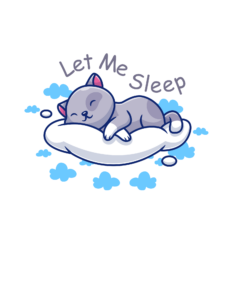The Science of Cat Naps: Why Cats Sleep So Much and What It All Means

If you’ve ever watched a cat sleep, you might have wondered how they can clock in so many hours of rest while still maintaining a playful and alert demeanor when they’re awake.
As a cat sitter, I’ve witnessed firsthand how cats can snooze through the day, only to spring into action when the sun goes down. But have you ever asked yourself why cats sleep so much? Or why your cat suddenly switches up their sleeping spot?
It turns out, there’s a lot of science behind your cat’s nap schedule. From evolutionary instincts to how they process the world around them, cats’ sleep patterns are complex and fascinating. Let’s dive into the science behind feline naps, explore what different sleeping positions reveal about their mood and health, and understand why their choice of sleeping spot might not be as random as it seems.
Why Do Cats Sleep So Much?
On average, cats sleep between 12 to 16 hours a day, that’s almost two-thirds of their life spent dozing! But why?
1. Evolutionary Survival Instincts
Cats are natural-born predators. In the wild, big cats like lions and leopards conserve energy by sleeping during the day so they can hunt at night. Domesticated cats have inherited this same instinct. Dr. Nicholas Dodman, an animal behaviorist and professor at Tufts University, explains,
“Cats are crepuscular, which means they are most active during dawn and dusk. Their ancestors hunted during these times to catch prey when it was easiest. Even though our house cats are fed from bowls now, that innate behavior remains hardwired.”
Because hunting requires short bursts of high-energy activity, cats instinctively rest for long periods to restore their strength. This cycle is so ingrained that even indoor cats, who don’t need to hunt, still follow these sleep patterns.
2. Light Sleep with Quick Reflexes
Cats alternate between light sleep (also called slow-wave sleep) and REM sleep (where dreams occur). About 75% of a cat’s sleep time is light sleep, which means they remain alert to sounds and movement. This explains why your cat can appear to be in a deep sleep but suddenly spring into action if they hear a noise.
Dr. John Bradshaw, author of Cat Sense, notes:
“Even when they’re sleeping, cats maintain a level of alertness that allows them to react quickly to threats or opportunities. This kind of light sleep helps them stay safe in the wild.”
3. Growth and Healing
Kittens and young cats sleep even more than adults because their bodies use that time for growth and development. Sleep triggers the release of growth hormones, which is essential for tissue repair and muscle growth. In older cats, extended sleep helps with healing and maintaining immune system function.
What Do Different Cat Sleeping Positions Mean?
Cats don’t just sleep anywhere, and they don’t sleep in the same position all the time. Their sleeping posture can reveal a lot about how they’re feeling—both emotionally and physically.
1. The Loaf Position
When a cat tucks its paws underneath and sits in a neat little bundle, it’s called the “loaf.” This position suggests that the cat feels secure but is not in deep sleep. It’s a way for them to rest while still being ready to spring into action if needed.
2. Curled Up (Crescent Shape)
This is one of the most common positions—your cat curled into a tight ball with their tail wrapped around their body. This position is all about conserving body heat and protecting their vital organs. Cats often curl up like this when they feel safe but also want to stay warm.
3. Belly-Up (Sprawled on Their Back)
When a cat lies on its back and exposes its belly, it’s the ultimate sign of trust. The stomach is the most vulnerable area for a cat, so when they expose it, they’re saying they feel completely at ease. However, despite the tempting display, this isn’t always an invitation for belly rubs!
4. Side Sleeping (Stretched Out)
A cat that sleeps stretched out on its side is in a state of deep relaxation. This position allows for full muscle relaxation and indicates that your cat feels comfortable and safe in its environment.
5. The “Superman” Pose
When a cat lies on its stomach with its front paws stretched out like Superman in flight, it often signals a combination of light sleep and readiness to pounce. It’s common in younger cats who want to rest without being fully vulnerable.
Where They Sleep and Why It Matters
Cats are picky about where they sleep, and their choice of sleeping spot is never random. Where they nap can reveal a lot about their mood, health, and level of trust.
1. High Perches
Cats instinctively seek out high vantage points where they can observe their surroundings while feeling secure. In the wild, a higher spot keeps them safe from predators. Even in a home, a cat’s preference for high places like shelves, cat trees, or the back of the couch is linked to this need for safety.
2. Hiding in Small Spaces
If your cat is napping in a box, under the bed, or tucked inside a closet, they’re seeking a space where they feel protected. Dr. Claudia Vinke, a researcher at Utrecht University, found that providing hiding spots significantly reduces stress in cats, particularly in unfamiliar environments.
3. Sleeping Near You
When a cat chooses to sleep next to you or on your lap, it’s a sign of trust and affection. Cats are vulnerable when they sleep, so being close to you means they feel safe and comfortable. A 2019 study from Oregon State University even found that cats form attachment bonds with their owners that are similar to those seen in dogs and human babies.
4. Warm and Sunlit Spots
Cats gravitate toward warm places, often soaking up the sun by a window or curling up near a heater. Cats maintain a higher baseline body temperature (around 102°F), so they naturally seek warmth to conserve energy.
Do Cats Dream?
Yes, cats dream! Just like humans, cats experience REM sleep, the phase where dreaming occurs. During REM, you may notice your cat’s whiskers twitching, paws moving, or even hear soft vocalizations.
Dr. Matthew Wilson, a neuroscientist at MIT, explains:
“We have found that cats, like other animals, process memories and experiences while they dream. Their movements during sleep often reflect events from their waking hours.”
This might explain why your cat seems to be chasing something in their sleep—perhaps they’re reliving a playful moment or a hunt.
When Should You Worry About Your Cat’s Sleep?
While excessive sleeping is normal for cats, sudden changes in sleep patterns can be a sign that something is wrong. Here’s what to watch for:
Increased Sleep with Lethargy: If your cat is sleeping more than usual and seems lethargic when awake, it could be a sign of illness, pain, or depression.
Restlessness at Night: If your cat is overly restless or vocal during the night, it could be due to cognitive dysfunction, especially in older cats.
Sudden Change in Sleeping Spots: Cats are creatures of habit. If they suddenly stop sleeping in their usual places or start hiding excessively, it may indicate discomfort or stress.
Our Cat Sitting Experience at Blackheath Whiskers
At Blackheath Whiskers Cat Sitting, we’ve had the privilege of caring for cats with all sorts of unique sleeping habits. From senior cats who prefer cozy, quiet corners to energetic kittens who crash into a nap after a burst of playtime, we’ve seen it all.
When you leave your cat with us, we don’t just ensure they’re fed and their litter is clean—we also pay close attention to their sleeping patterns. Changes in where or how they sleep can tell us a lot about their well-being. We make note of these subtle shifts and adjust their environment or routine as needed to keep them comfortable and stress-free.
Why Choose Blackheath Whiskers Cat Sitting for Your Cat Sitting Needs?
1. Personalized Care: We adapt to your cat’s routine, preferences, and sleeping habits to ensure they remain comfortable and stress-free.
2. Experience and Expertise: We’ve cared for cats with diverse needs, from energetic kittens to senior cats with health concerns.
3. Peace of Mind: We provide regular updates, including photos and notes on your cat’s behavior, so you can relax knowing they’re in good hands.
4. Commitment to environment and feline charity: Eco-friendly, cycling cat sitting service and we donate 50p to Cats Protection per cat sitting visit.
Get in Touch with Blackheath Whiskers Cat Sitting
If you’re looking for trustworthy, experienced cat sitters who will treat your feline friend like royalty, we’d love to hear from you!
Contact Us:
Email: blackheathwhiskers@gmail.com
Website: blackheathwhiskers.co.uk
Let Blackheath Whiskers give you peace of mind while ensuring your cat stays happy, comfortable, and well-cared for at home. Reach out today to schedule a consultation or learn more about our services.
